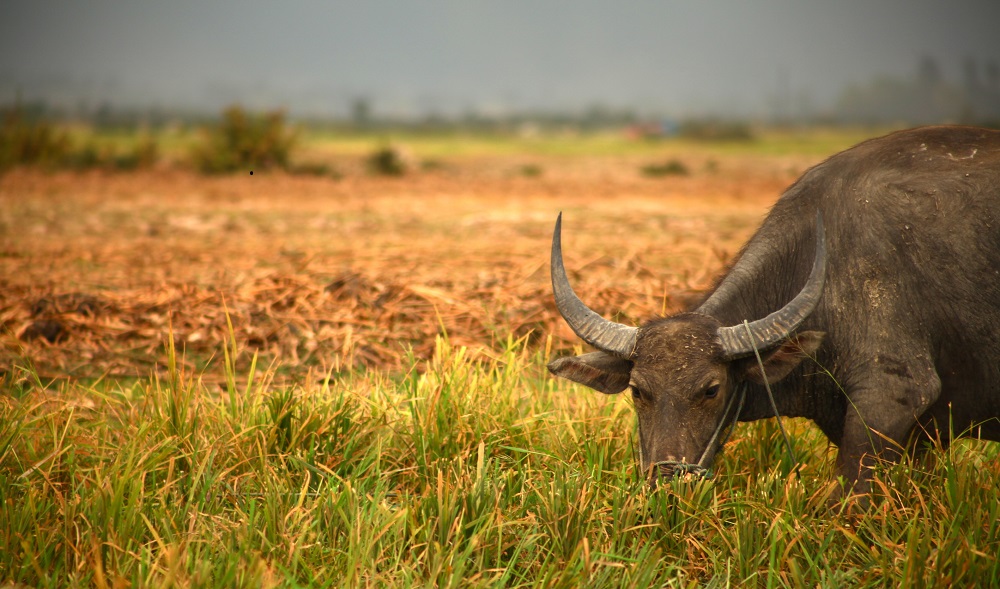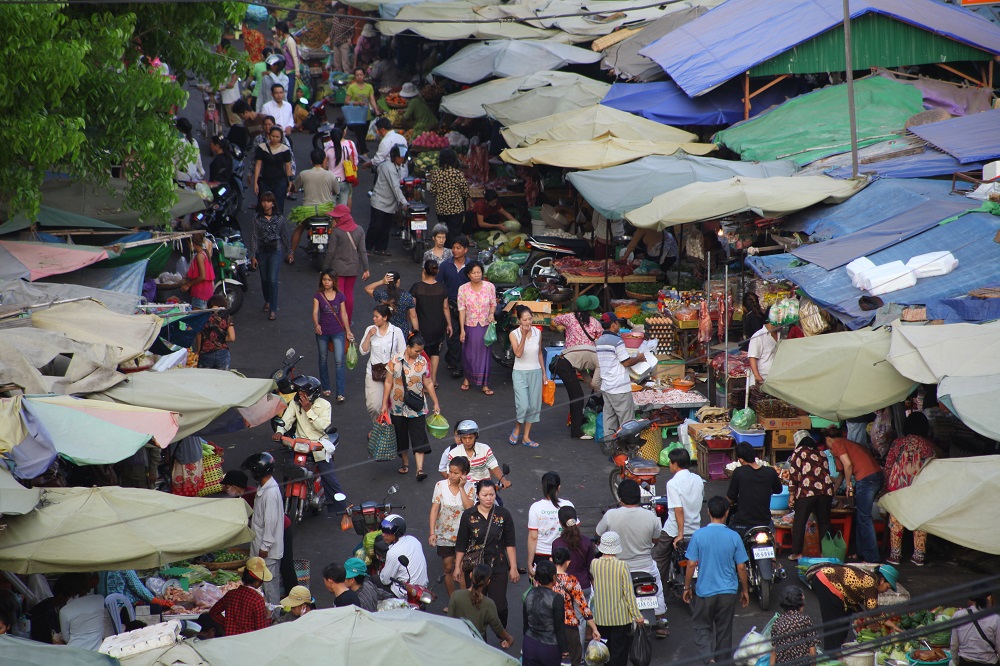Growing dry-season crops after rice on hard-setting soils can pose serious challenges to Cambodian farmers seeking to diversify and intensify with greater efficiency, profitability, and sustainability.

Fried frog legs and duck tongues are still sizzling on the hot plate plonked down in front of me. My Cambodian dinner acquaintances smile broadly. I sometimes question whether the serving of these local delicacies is an act of hospitality or the blunt end of a wry sense of humor testing the reaction of foreigners trying hard not to offend.
Cambodians love their food and love eating it with company. No one should eat alone, they say. It’s not surprising they appreciate sitting down with friends, family, and workmates to multiple plates piled with steaming greens, succulent meats, and a hefty serving of rice, as the horrific past of hunger, community dislocation, and nationwide devastation lingers in the not-too-distant past (see Revisiting the “Killing Fields”).
Rice culture and cultivation
The staple food of Cambodians is rice. Only a few kilometers out from the capital city of Phnom Penh are verdant rice paddies offering a tranquil reprieve from the city’s hustle and bustle.
Rice-based farming systems have been the mainstay of rural livelihoods in Southeast Asia for centuries. However, trends suggest an increasing diversification and intensification1 within these systems, which are opening up new opportunities for farmers as well as highlighting existing production constraints.
Puddling or wet cultivation is the traditional method of land preparation for establishing rice─a practice that destroys soil aggregates, breaks the capillary pores through which water enters, disperses clay particles, and lowers soil strength in the puddled layer.2–4 Repeated puddling leads to the formation of a dense layer of soil or hardpan below the topsoil layer that helps retain water in flooded rice fields. The hardpan has high bulk density, which reduces water loss through drainage and allows the field to maintain standing water required in growing the rice crop.5

Going beyond rice
In continuous rice culture, the formation and maintenance of the compacted lower soil layer that reduces water infiltration can be considered an investment in infrastructure. In the rice–nonrice system, however, the destruction of surface soil structure and the development of the hardpan can impose serious liabilities on the establishment and performance of crops grown after rice.
In Cambodia, hard-setting soils are widespread and strongly influence crop production during the dry season as these tend to limit the retention, movement, and plant use of water and nutrients.6 This is due to two contrasting unfavorable physical conditions at different water contents, namely, the complete breakdown of large, air-dry soil aggregates into microaggregates with sudden immersion in water (slaking)7,8 and an extremely hard structureless mass formed during drying9, with a positive correlation between hard-setting and bulk density.10
Irrigation or rainfall after sowing can cause the soil surface to collapse while the subsequent drying may harden the surface, preventing the seedlings from emerging11 or impeding the root growth of established plants.9
Growing dry-season crops after rice on hard-setting soils can pose serious challenges for farmers in Cambodia. Further understanding how land formation techniques (leveling, grading, and raised-bed construction) for improved water and nutrient management and efficiencies affect soil structure and the behavior of nutrient and water dynamics is required to develop refined and integrated management practices and realize the potential of high-value non-rice crops.
Dry-season farm productivity
The Australian Centre for International Agricultural Research (ACIAR) project Improving water and nutrient management to enable double cropping in the rice-growing lowlands of Lao PDR and Cambodia is seeking to increase dry-season farm productivity through irrigation design, better use of residual soil moisture, and clever nutrient strategies. A multi-year maize trial conducted on a hard-setting lowland Prateah Lang soil with the Cambodian Agricultural Research and Development Institute (CARDI) is investigating soil-water-plant dynamics with irrigation frequency, volume, and application method on soils amended with agricultural residues (rice straw, cattle manure, and biochar).
Land leveling, grading for slope, and raised-bed construction are used to improve water and nutrient management and efficiencies. Leveling can assist in water application as field gradients can reduce waterlogging in poorly drained soil types.12 Crops grown on beds and furrow irrigated may experience slow wetting through capillary action, thereby reducing soil aggregate disruption.6,13 However, despite land formation to improve irrigation water application, movement, and drainage, these practices risk exacerbating inherent hard-setting tendencies where there has been significant loss of soil organic matter as a result of topsoil removal (resulting in the loss of more labile fractions, which is an indicator of soil productivity and health)14 or significant disruption of the topsoil has taken place in the land-forming process.

The retention and incorporation of organic amendments in hard-setting soils can be an important factor when land-forming on these soil types. The nutrient- and water-holding capacity of soils can be increased by adding organic amendments,15,16 thereby enhancing soil fertility and increasing crop productivity.17,18 Crop residue mulch, livestock manure, and biochar have been found to suppress weeds,15,19 elevate soil fertility,20,21 increase crop nitrogen uptake,22 lower soil temperature23 and tensile strength,24 induce occlusion,25 reduce soil water evaporation,15 enhance lateral and vertical soil water movement, and improve crop root movement for access to nutrients and water.26
There is no misconception of the challenges that face the agricultural industry in this part of the world as farmers look to new horizons in production, water management, and nutrient strategies. It is therefore important that research on improving water and nutrient management for double cropping in Southeast Asia be undertaken as farmers seek to diversify and intensify with greater resource-use efficiency, profitability, and sustainability.
After a long, hot day in the field, there is no greater reward than sitting down with my Khmer colleagues, reflecting on the good work achieved and discussing the obstacles still to be overcome. The food on the table might be new and exotic; however, in the company of an ever-effervescent group laughing loudly at lost translations and giving detailed explanations of how the food is grown, it is hard not to enjoy the tastes and experiences of Cambodia.
___________________________
Ms. Molesworth is a PhD candidate and works at the Centre for Regional and Rural Futures investigating soil-water-crop dynamics in Australia and Cambodia.
References:
- Cramb RA et al. 2015. Rice-based farming systems in Mainland Southeast Asia. Australian Centre for International Agricultural Research.
- Hobbs PR, Gupta RK. 2000. Sustainable resource management in intensively cultivated irrigated rice-wheat cropping systems of the lndo-Gangetic Plains of South Asia: Strategies and options. Paper presented at the International Conference on “Managing natural resources for sustainable production in the 21st century.” New Delhi, India, 14-18 Feb. 2000. Rice-Wheat Facilitation Unit, IARI, New Delhi. India, and CIMMYT, Mexico.
- Sharma PK, De Datta SK. 1986. Physical properties and processes of puddled rice soils. Adv. Soil Sci. 5:139–178 doi: 10.1007/978-1-4613-8660-5_3.
- Gupta RK, Naresh RK, Hobbs PR, Jiaguo Z, Ladha JK. 2003. Sustainability of post-green revolution agriculture: The rice–wheat cropping systems of the Indo-Gangetic Plains and China. In: Improving the Productivity and Sustainability of Rice–Wheat Systems: Issues and Impacts. Madison, WI (USA): American Society of Agronomy, Crop Science Society of America, and Soil Science Society of America. p 1−25. doi: 10.2134/asaspecpub65.c1
- Wopereis MCS, Stein A, Bouma J, Woodhead T. 1992. Sampling number and design for measurements of infiltration rates into puddled rice fields. Agric. Water Manag. 21:281–295.
- Daniells IG. 2012. Hardsetting soils: A review. Soil Res. 50:349–359.
- Breuer J, Schwertmann U. 1999. Changes to hardsetting properties of soil by addition of metal hydroxides. Eur. J. Soil Sci. 50:657–664.
- Loch RJ. 1995. Structure breakdown on wetting. In: So HB, Smith GD, Raine SR, Schafer BM, Loch RJ. Sealing, crusting and hardsetting soils: Productivity and conservation. Australian Soil Science Society. p 113−133.
- Mullins CE, MacLeod DA, Northcote KH, Tisdall JM, Young IM. 1990. Hardsetting soils: Behavior, occurrence, and management. In: Lal R, Stewart BA, editors. Advances in Soil Science: Soil Degradation. Springer, New York. p 37−108. doi: 10.1007/978-1-4612-3322-0_2
- Fabiola N, Giarola B, Da Silva AP, Imhoff S, Dexter AR. 2003. Contribution of natural soil compaction on hardsetting behavior. Geoderma 113:95–108.
- Mullins CE, Young IM, Bengough AG, Ley GJ. 1987. Hard-setting soils. Soil Use Manag. 3:79–83.
- Nesbitt HJ, Johnston R, Solieng M. 2004. Mekong River water: Will river flows meet future agricultural needs in the Lower Mekong Basin? In: ACIAR Proceedings 116e. p 86–104.
- Murray RS, Grant CD. 2007. The impact of irrigation on soil structure. The national program for sustainable irrigation. Land and Water Australia.
- Bronick CJ, Lal R. 2005. Soil structure and management: A review. Geoderma 124:3–22.
- Bunna S, Sinath P, Makara O, Mitchell J, Fukai S. 2011. Effects of straw mulch on mungbean yield in rice fields with strongly compacted soils. Field Crops Res. 124:295–301.
- Arif M et al. 2016. Integration of biochar with animal manure and nitrogen for improving maize yields and soil properties in calcareous semi-arid agroecosystems. Field Crops Res. 195:28–35.
- Clark GJ, Dodgshun N, Sale PWG, Tang C. 2007. Changes in chemical and biological properties of a sodic clay subsoil with addition of organic amendments. Soil Biol. Biochem. 39:2806–2817.
- Blackwell P, Krull E, Butler G, Herbert A, Solaiman Z. 2010. Effect of banded biochar on dryland wheat production and fertiliser use in south-western Australia: An agronomic and economic perspective. Soil Res. 48:531–545.
- Pheng S, Olofsdotter M, Jahn G, Adkins S. 2010. Use of phytotoxic rice crop residues for weed management. Weed Biol. Manag. 10:176–184.
- Masulili A, Utomo WH, Syechfani MS. 2010. Rice husk biochar for rice based cropping system in acid soil. 1. The characteristics of rice husk biochar and its influence on the properties of acid sulfate soils and rice growth in West Kalimantan, Indonesia. J. Agric. Sci. 2:39–47.
- Carter S, Shackley S, Sohi S, Suy TB, Haefele S. 2013. The impact of biochar application on soil properties and plant growth of pot grown lettuce (Lactuca sativa) and cabbage (Brassica chinensis). Agronomy 3:404–418.
- Verma TS, Bhagat RM. 1992. Impact of rice straw management practices on yield, nitrogen uptake and soil properties in a wheat-rice rotation in northern India. Fertil. Res. 33:97–106.
- Lal R. 1974. Soil temperature, soil moisture and maize yield from mulched and unmulched tropical soils. Plant Soil 40:129–143.
- Chan KY, Van Zwieten L, Meszaros I, Downie A, Joseph S. 2007. Agronomic values of green waste biochar as a soil amendment. Aust. J. Soil Res. 45:629–634.
- Zaher H, Caron J. 2008. Aggregate slaking during rapid wetting: Hydrophobicity and pore occlusion. Can. J. Soil Sci. 88:85–97.
- Erenstein O. 2002. Crop residue mulching in tropical and semi-tropical countries: An evaluation of residue availability and other technological implications. Soil Tillage Res. 67:115–133.





